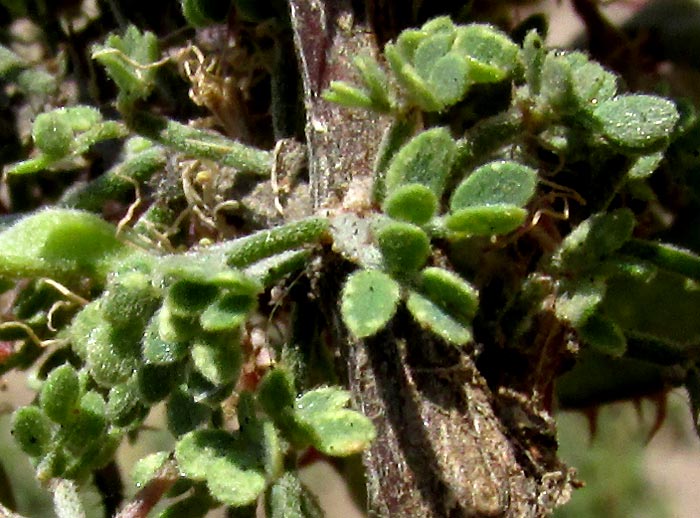Excerpts from Jim Conrad's
Naturalist Newsletter
entry dated March 22, 2022, issued from near Tequisquiapan, elevation about 1,900m (6200 ft), ~N20.57°, ~ W99.89°, Querétaro state, MÉXICO
CATCLAW MIMOSA FLOWERING
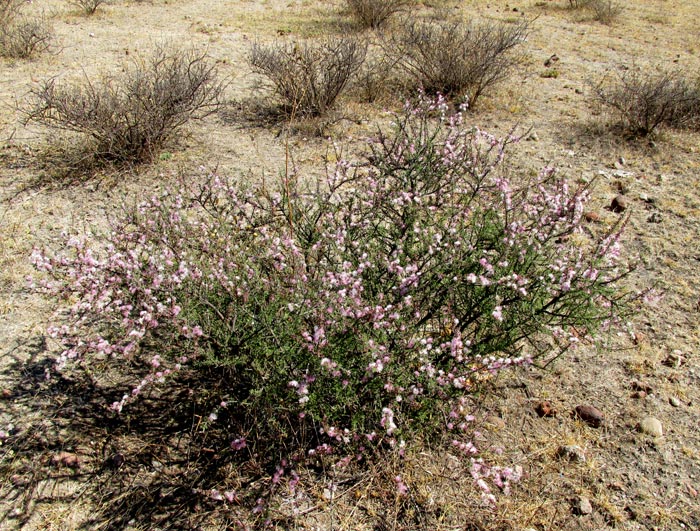
Nowadays as the late dry-season landscape is mostly in tones of sun-bleached gray and brown, in an open, scrubby area occasionally nibbled by passing cows, goats and sheep, the above waist-high, toughly wiry and scratchy shrub was one of few in the areas loaded with mixed pinkish and white flowers, and emerging leaves. Up closer, the flowers showed themselves to be clustered in spherical, acacia-like heads, as seen below:
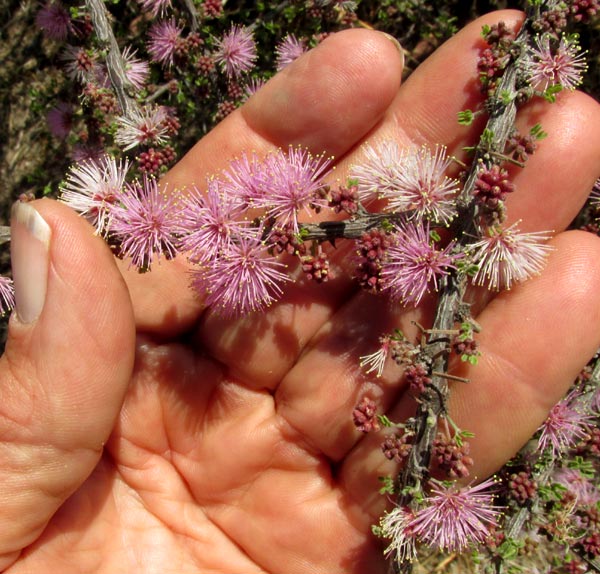
Below is a closer look at some heads, as well as twice-compound leaves, emerging from buds.

When you see flowering heads like that mostly consisting of long, slender stamens radiating from tiny corollas almost hidden by the stamens, you can be fairly sure that you're dealing with one of the Bean Family's three big subfamilies, the Mimosoideae, in which you find many species of mimosas and acacias, and a host of smaller kinds. Our arid upland location is especially rich in members of this subfamily. In our general area, known as the Bajío, the subfamily consists of 18 genera with 67 species. Sometimes figuring out which is which can be a challenge.
A good place to start when identifying members of the Mimosa Subfamily is to count the number of stamens. Flowers of mesquites and the big genus Mimosa bear up to ten stamens; the numerous acacias and other lesser-known members of the subfamily have ten or more stamens. Below you can see how many stamens a flower from our tree produce:
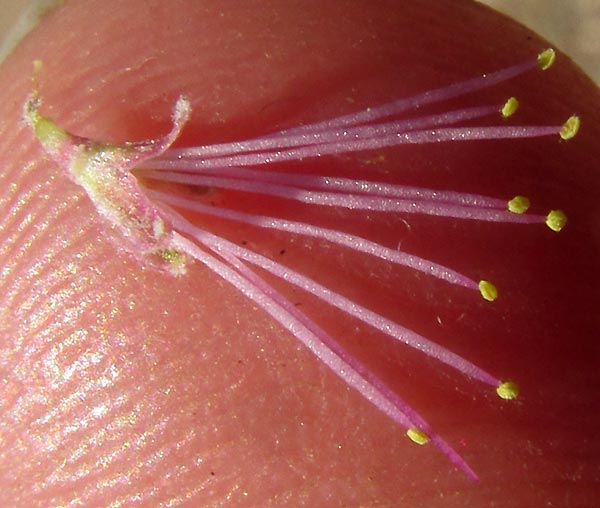
The slender item not tipped with a yellow anther is the style issuing from atop the ovary hidden within the corolla on the picture's left side. We know our abundant, wonderful mesquites well enough to know this isn't a mesquite flower, so we have a member of the genus Mimosa, of which there over 500 species, 90% occurring in the Americas. Mexico is home to over 100 mimosa species, and in our arid Bajío upland central Mexico region, we have 15.
Most mimosas I know not only produce twice-divided leaves, but also there are several first-divisions of the leaf, and then each of those first divisions is dived in numerous, often very many, confetti-like leaflets. Our mimosa is a little unusual, then, as you can see from the two emerging leaves shown below:
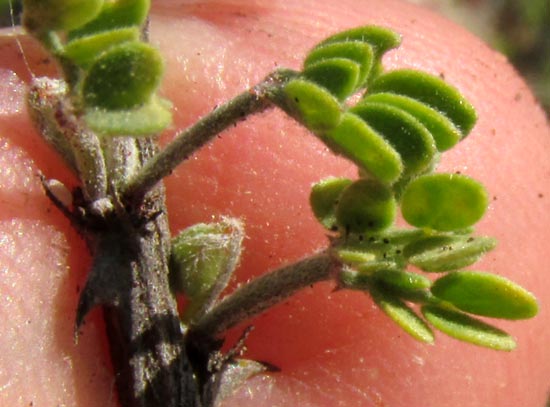
These leaves have only two primary divisions, each of which bears only four or six leaflets, and no emerging leaves on this bush could be found with more. That feature alone eliminates about half our potential Mimosa species.
One of the remaining species at first glance looks like the Texas Mimosa we had in southwestern Texas, with which you can compare at https://www.backyardnature.net/n/w/mimosa-t.htm. The leaves of that species, though, usually produce more primary and secondary divisions. Other features of our Querétaro mimosa disqualify all but one of the remaining species. Those features include the spines on our tree arising in pairs at the leaf petiole base, and they are thick-based, and curved, not slender and straight. Also, the petioles and leaflets are softly short-hairy, or "puberulent," and the ultimate leaflets are quite small, only to about 7mm long.
All these features and by comparing our plant with pictures on the Internet lead to the Catclaw Mimosa, MIMOSA MONANCISTRA, endemic just to arid regions of upland northern and central Mexico, with our location being at the southernmost end. It's described as frequent in disturbed areas where originally tropical-deciduous forest stood, especially in arid scrub, between 1100-2600 meters.
entry dated May 1, 2022, issued from near Tequisquiapan, elevation about 1,900m (6200 ft), ~N20.57°, ~ W99.89°, Querétaro state, MÉXICO
CATCLAW MIMOSA FRUITING
The same plants profiled above now bear cluttered clusters of ripening legumes, shown below:

The legumes show two features important in mimosa identification: they're constricted between the beans, and; their margins bear conspicuous broad-based, sharp-pointed, curved spines:
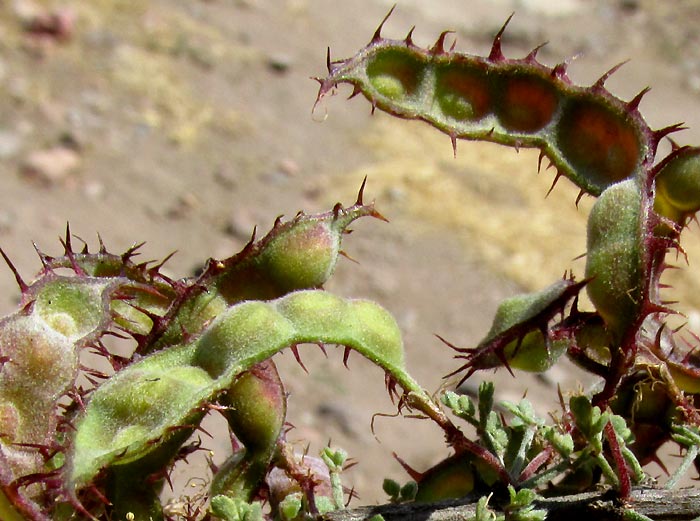
The hairy leaves haven't grown much since photographing them in March:
